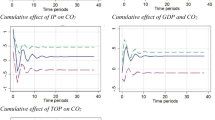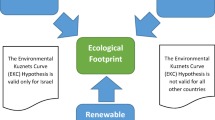Abstract
This study examines the role of technological innovation and economic progress on environmental pollution by using STRIPAT and EKC theoretical frameworks in 25 developing Asian countries from the period 1998 to 2019. For technological advancement, the energy intensity has been used to gauge how much of the quantity of energy is employed to produce the additional unit of gross domestic product at domestic level. Therefore, the volume of the energy used in the production process is highly important as it is documented through the energy intensity. To capture the impact of innovation, the sum of total patent applications and trademark applications for the sampled countries has been used. This study applied second-generation unit root and panel cointegration techniques to estimate the results. To estimate the long-run relationship of variables and the cross-sectional interdependence, Pedroni Residual and Westerlund Cointegration tests are applied. Further, the Hausman-Taylor-type test has been used to check the efficiency of the pool mean group (PMG). The results of PMG regression confirm the existence of EKC in the developing Asian countries. The results of this study showed that technological development, innovations, and economic progress have the potential to reduce carbon emission and to protect the environment in developing Asian economies. Moreover, the results of error correction model indicate that in case of any external shock, this model will converge towards equilibrium within 64.6 years. The study proposed that a policy framework related to technological innovations should be sustained and the advancement of human capital and research and development should be the primary focus of the developing nations to mitigate the environmental challenges.
Similar content being viewed by others
Data availability
Not applicable.
References
Abdelfattah YM, Abou-Ali H, Adams J (2018) Population dynamics and CO2 emissions in the Arab region: an extended STIRPAT II model. Middle East Dev J 10(2):248–271
Acheampong AO (2018) Economic growth, CO2 emissions and energy consumption: what causes what and where? Energy Econ 74:677–692
Altıntaş H, Kassouri Y (2020) Is the environmental Kuznets Curve in Europe related to the per-capita ecological footprint or CO2 emissions? Ecol Indic 113:106187
Arroyo M, Flavio R, Migue LJ (2020) The trends of the energy intensity and CO2 emissions related to final energy consumption in Ecuador: scenarios of national and worldwide strategies. Sustainability 12(1):20
Azam M, Khan AQ (2016) Testing the Environmental Kuznets Curve hypothesis: a comparative empirical study for low, lower middle, upper middle and high income countries. Renew Sust Energ Rev 63:556–567
Bekun FV, Emir F, Sarkodie SA (2019) Another look at the relationship between energy consumption, carbon dioxide emissions, and economic growth in South Africa. Sci Total Environ 655:759–765
Blomquist J, Westerlund J (2013) Testing slope homogeneity in large panels with serial correlation. Econ Lett 121(3):374–378
Cansino JM, Román-Collado R, Molina JC (2019) Quality of institutions, technological progress, and pollution havens in Latin America. An analysis of the Environmental Kuznets curve hypothesis. Sustainability 11(13):3708
Churchill SA, Inekwe J, Smyth R, Zhang X (2019) R&D intensity and carbon emissions in the G7: 1870–2014. Energy Econ 80:30–37
Cui H, Zhao T, Shi H (2018) STIRPAT-based driving factor decomposition analysis of agricultural carbon emissions in Hebei, China. Pol J Environ Stud 27(4):1449–1461
Destek MA, Ulucak R, Dogan E (2018) Analyzing the environmental Kuznets curve for the EU countries: the role of ecological footprint. Environ Sci Pollut Res 25(29):29387–29396
Dinda S (2018) Production technology and carbon emission: long-run relation with short-run dynamics. J Appl Econ 21(1):106–121
Dogan E, Taspinar N, Gokmenoglu KK (2019) Determinants of ecological footprint in MINT countries. Energy Environ 30(6):1065–1086
Emir F, Bekun FV (2019) Energy intensity, carbon emissions, renewable energy, and economic growth nexus: new insights from Romania. Energy Environ 30(3):427–443
Hanif I (2017) Economics-energy-environment nexus in Latin America and the Caribbean. Energy 141:170–178
Hanif I (2018a) Energy consumption habits and human health nexus in Sub-Saharan Africa. Environ Sci Pollut Res 25(22):21701–21712
Hanif I (2018b) Impact of economic growth, nonrenewable and renewable energy consumption, and urbanization on carbon emissions in Sub-Saharan Africa. Environ Sci Pollut Res 25(15):15057–15067
Hanif I (2018c) Impact of fossil fuels energy consumption, energy policies, and urban sprawl on carbon emissions in East Asia and the Pacific: a panel investigation. Energy Strategy Rev 21:16–24
Hanif I, Gago-de-Santos P (2017) The importance of population control and macroeconomic stability to reducing environmental degradation: an empirical test of the environmental Kuznets curve for developing countries. Environ Dev 23:1–9
Hanif I, Aziz B, Chaudhry IS (2019a) Carbon emissions across the spectrum of renewable and nonrenewable energy use in developing economies of Asia. Renew Energy 143:586–595
Hanif I, Raza SMF, Gago-de-Santos P, Abbas Q (2019b) Fossil fuels, foreign direct investment, and economic growth have triggered CO2 emissions in emerging Asian economies: some empirical evidence. Energy 171:493–501
Hanif I, Wallace S, Gago-de-Santos P (2020) Economic growth by means of fiscal decentralization: an empirical study for federal developing countries. SAGE Open 10(4):2158244020968088
Huang J, Luan B, Cai X, Zou H (2020) The role of domestic R&D activities played in carbon intensity: evidence from China. Sci Total Environ 708:135033
Ibrahim SS, Celebi A, Ozdeser H, Sancar N (2017) Modelling the impact of energy consumption and environmental sanity in Turkey: a STIRPAT framework. Procedia Comp Sc 120:229–236
Khan AQ, Saleem N, Fatima ST (2018) Financial development, income inequality, and CO 2 emissions in Asian countries using STIRPAT model. Environ Sci Pollut Res 25(7):6308–6319
Kilbourne WE, Thyroff A (2020) STIRPAT for marketing: an introduction, expansion, and suggestions for future use. J Bus Res 108:351–361
Lau LS, Choong CK, Eng YK (2014) Investigation of the environmental Kuznets curve for carbon emissions in Malaysia: do foreign direct investment and trade matter? Energy Policy 68:490–497
Lee KH, Min B (2015) Green R&D for eco-innovation and its impact on carbon emissions and firm performance. J Clean Prod 108:534–542
Li T, Wang Y, Zhao D (2016) Environmental Kuznets curve in China: new evidence from dynamic panel analysis. Energy Policy 91:138–147
Liang X, Gong Q, Zheng H, Xu J (2020) Examining the impact factors of the water environment using the extended STIRPAT model: a case study in Sichuan. Environ Sci Pollut Res 27(12):12942–12952 1-11
Lin B, Zhu J (2019) The role of renewable energy technological innovation on climate change: empirical evidence from China. Sci Total Environ 659:1505–1512
Liobikienė G, Butkus M (2017) Environmental Kuznets Curve of greenhouse gas emissions including technological progress and substitution effects. Energy 135:237–248
Liu D, Xiao B (2018) Can China achieve its carbon emission peaking? A scenario analysis based on STIRPAT and system dynamics model. Ecol Indic 93:647–657
Ozturk I, Al-Mulali U (2015) Investigating the validity of the environmental Kuznets curve hypothesis in Cambodia. Ecol Indic 57:324–330
Majeed MT, Mazhar M (2020) Reexamination of environmental Kuznets curve for ecological footprint: the role of bio capacity, human capital, and trade. Pak J Commer Soc Sci 14(1):202–254
Marsiglio S, Ansuategi A, Gallastegui MC (2016) The environmental Kuznets curve and the structural change hypothesis. Environ Resour Econ 63(2):265–288
Mensah CN, Long X, Dauda L, Boamah KB, Salman M (2019) Innovation and CO 2 emissions: the complimentary role of eco-patent and trademark in the OECD economies. Environ Sci Pollut Res 26(22):22878–22891
Nazir MI, Nazir MR, Hashmi SH, Ali Z (2018) Environmental Kuznets curve hypothesis for Pakistan: empirical evidence form ARDL bound testing and causality approach. Int J Green Energy 15(14-15):947–957
Onafowora OA, Owoye O (2014) Bounds testing approach to analysis of the environment Kuznets curve hypothesis. Energy Econ 44:47–62
Ongan S, Isik C, & Ozdemir D (2020). Economic growth and environmental degradation: evidence from the US case environmental Kuznets curve hypothesis with application of decomposition. J Environ Econ Policy, 1-8.
Özokcu S, Özdemir Ö (2017) Economic growth, energy, and environmental Kuznets curve. Renew Sust Energ Rev 72:639–647
Perman R, Ma Y, McGilvray J, & Common M (2003). Natural resource and environmental economics. Pearson Educ.
Pesaran MH, Yamagata T (2008) Testing slope homogeneity in large panels. J Econ 142(1):50–93
Shahbaz M, Loganathan N, Muzaffar AT, Ahmed K, Jabran MA (2016a) How urbanization affects CO2 emissions in Malaysia? The application of STIRPAT model. Renew Sust Energ Rev 57:83–93
Shahbaz M, Shahzad SJH, Ahmad N, Alam S (2016b) Financial development and environmental quality: the way forward. Energy Policy 98:353–364
Shahbaz M, Solarin SA, Sbia R, Bibi S (2015) Does energy intensity contribute to CO2 emissions? A trivariate analysis in selected African countries. Ecol Indic 50:215–224
Shi X, Liu H, Riti JS (2019) The role of energy mix and financial development in greenhouse gas (GHG) emissions’ reduction: evidence from ten leading CO 2 emitting countries. Econ Polit 36(3):695–729
Shaari MS, Abdul Karim Z, Zainol Abidin N (2020) The effects of energy consumption and national output on CO2 emissions: new evidence from OIC countries using a panel ARDL analysis. Sustainability 12(8):3312
Sinha A, Shahbaz M (2018) Estimation of environmental Kuznets curve for CO2 emission: role of renewable energy generation in India. Renew Energy 119:703–711
Todaro MP, & Smith SC (2015). Economic Development. 12th edition Peasron.
Usman O, Iorember PT, Olanipekun IO (2019) Revisiting the environmental Kuznets curve (EKC) hypothesis in India: the effects of energy consumption and democracy. Environ Sci Pollut Res 26(13):13390–13400
Wang P, Wu W, Zhu B, Wei Y (2013) Examining the impact factors of energy-related CO2 emissions using the STIRPAT model in Guangdong Province, China. Appl Energy 106:65–71
Wang S, Zhao T, Zheng H, Hu J (2017) The STIRPAT analysis on carbon emission in Chinese cities: an asymmetric laplace distribution mixture model. Sustainability 9(12):2237
World Bank (2020) World development indicators 2016. World Bank Publications, cop, Washington
Wu J, Zhu Q, Liang L (2016) CO2 emissions and energy intensity reduction allocation over provincial industrial sectors in China. Appl Energy 166:282–291
Xing T, Jiang Q, Ma X (2017) To facilitate or curb? The role of financial development in China’s carbon emissions reduction process: a novel approach. Int J Environ Res Public Health 14(10):1222
Yang Z, Abbas Q, Hanif I, Alharthi M, Taghizadeh-Hesary F, Aziz B, Mohsin M (2020) Short-and long-run influence of energy utilization and economic growth on carbon discharge in emerging SREB economies. Renew Energy 165:43–51
Yeh JC, Liao CH (2019) Impact of population and economic growth on carbon emissions in Taiwan using an analytic tool STIRPAT. Sustain Environ Res 27(1):41–48
Zhang Y, Zhang Q, Pan B (2019) Impact of affluence and fossil energy on China carbon emissions using STIRPAT model. Environ Sci Pollut Res 26(18):18814–18824
Zhu J, Fan Y, Deng X, Xue L (2019) Low-carbon innovation induced by emissions trading in China. Nat Commun 10(1):1–8
Zhou Z (2019) The underground economy and carbon dioxide (CO2) emissions in China. Sustainability 11(10):2802
Zineb SB (2016) International trade and CO2 emissions: a dynamic panel data analysis by the STIRPAT model. J Econ Sustain Dev 7(12):94–104
Zoundi Z (2017) CO2 emissions, renewable energy and the environmental Kuznets curve, a panel cointegration approach. Renew Sust Energ Rev 72:1067–1075
Author information
Authors and Affiliations
Contributions
Wu Hao: initial draft preparation; Farhat Rasul (corresponding author Email:farhat.rasul@umt.edu.pk): econometric results estimation, hypothesis testing; Zobia Bhatti: review of literature, data collection, and tabulation; Muhammad Shahid Hassan: results interpretation and diagnostic testing; Ishtaiq Ahmed: methodological framework; Nabeela Asghar: proof reading and technical advice.
Corresponding author
Ethics declarations
Ethical approval
This is an original work that has not been submitted anywhere else for publication.
Consent to participate
All authors have contributed in the submitted paper. There is no conflict of interest to disclose.
Consent to publish
The paper submitted with the mutual consent of authors for publication in Environmental Science and Pollution Research.
Competing interests
The authors declare that they have no competing interests.
Additional information
Responsible Editor: Nicholas Apergis
Publisher’s note
Springer Nature remains neutral with regard to jurisdictional claims in published maps and institutional affiliations.
Appendix
Appendix
Rights and permissions
About this article
Cite this article
Hao, W., Rasul, F., Bhatti, Z. et al. A technological innovation and economic progress enhancement: an assessment of sustainable economic and environmental management. Environ Sci Pollut Res 28, 28585–28597 (2021). https://doi.org/10.1007/s11356-021-12559-9
Received:
Accepted:
Published:
Issue Date:
DOI: https://doi.org/10.1007/s11356-021-12559-9




